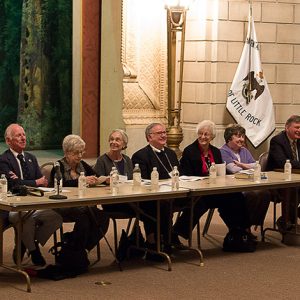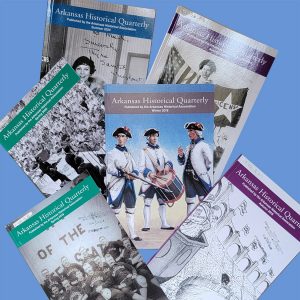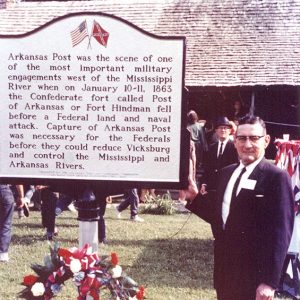calsfoundation@cals.org
Arkansas Historical Association (AHA)
The Arkansas Historical Association (AHA) is dedicated to maintaining an active statewide historical group involving all aspects of Arkansas’s history. The association holds annual conferences and publishes the Arkansas Historical Quarterly (AHQ). Headquartered at the University of Arkansas (UA) in Fayetteville (Washington County), which partially underwrites the expenses of the organization, the AHA assists historians and educators in Arkansas in preserving and interpreting the history of the state.
In 1903, John Hugh Reynolds, professor of history at UA, and a group of his students formed the Arkansas Historical Society, the forerunner of the AHA. The group soon realized that a continually changing student body made membership problematic and reorganized to become the first AHA. James Kimbrough Jones served as president. Charles Hillman Brough, J. S. King, David Yancey Thomas, and Eugene R. Long were elected vice presidents. R. J. Wilson served as treasurer and Reynolds as secretary. Jones had been, until that year, U.S. senator from Arkansas; Thomas and Brough were on the faculty at UA. Brough was later elected governor of Arkansas.
The first association held only two regular meetings over the next five years, on February 14, 1907, and May 22, 1908. Its most recognizable accomplishment is Reynolds’s editorial work on Publications of the Arkansas Historical Association. These four volumes contain an inventory of sources about the state of Arkansas and its history, as well as reprints of rare documents and new articles about the history of Arkansas. Reynolds managed to compile the first volume of Publications in 1906 despite financial difficulties. When the Arkansas History Commission (now called the Arkansas State Archives), created on April 27, 1905, became active in 1907, it elected Reynolds its secretary. The production of Publications was transferred to the commission’s responsibility. The first AHA subsequently ceased to meet, in part out of confidence that the AHC would accomplish the goals of the AHA. The AHC proved, however, to be poorly funded by the state at the time.
On February 22, 1941, in response to a publicized announcement by David Yancey Thomas, a group of about 100 people from all over Arkansas met in Little Rock (Pulaski County) to organize a permanent association and accompanying journal. Reynolds was elected as president of the renewed association. The objective was to “promote interest in the history of Arkansas, to locate, collect, and preserve historical material, and to publish scarce and important source material, and also historical articles, news, and notes.” This was the last time the group met until November 8, 1945, due to the United States’ involvement in World War II. Officers elected at this meeting included President Reynolds, Vice President Dallas T. Herndon (then the executive secretary of the AHC), and historian Fred Harrington (then on the faculty of UA and future president of the University of Wisconsin). A board of seven directors, one from each of the congressional districts of Arkansas at the time, included J. William Fulbright, the president of UA and future U.S. senator—as well as oilman and philanthropist Thomas H. Barton.
The group continued working on the main project of the renewed AHA, which was to plan a journal of state history. Thomas was chosen as editor, and with dues from current members and from a membership drive, the first issue of the Arkansas Historical Quarterly went to press in March 1942. The issue began with a salutatory message from Thomas and contained articles about the organization of Arkansas municipalities, a brief history of the petroleum industry in Arkansas, information about early inhabitants of Arkansas, and names of Revolutionary War soldiers buried in Arkansas, as well as book reviews and “News Notes.”
On May 7, 1955, a proposed revision to the mission statement dropped the phrase “scarce and important” and added “and such other material as is deemed worthy of publication” to the end of the statement. Today, the focus is “to promote the preservation, writing, publishing, teaching and understanding of Arkansas history through the publication of the Arkansas Historical Quarterly as well as other activities.” Early issues included many personal reminiscences and items of local interest; over the years, the Quarterly grew increasingly academic and serious in its writing. The AHA also played a strong role encouraging the Arkansas General Assembly to pass legislation in 1997 requiring that Arkansas history be taught in state schools.
At its annual conferences, the AHA hears presentations from speakers about a variety of topics relevant to the history of Arkansas. It also presents awards to writers and educators who have contributed to the study of Arkansas history. These include the James H. Atkinson Award for Excellence in the Teaching of Arkansas History; the J. G. Ragsdale Book Award in Arkansas History; the Violet B. Gingles Award for the best paper written about Arkansas history; the Lucille Westbrook Local History Prize for the best published article in a county or local journal; and the Walter L. Brown Awards for best articles of various kinds.
For additional information:
Arkansas Historical Association. http://www.arkansashistoricalassociation.org/ (accessed April 19, 2022).
“Constitution of the Arkansas Historical Association.” Arkansas Historical Quarterly 13 (Winter 1954): 386–387.
“Proposed Revised Constitution and By-laws of the Arkansas Historical Association.” Arkansas Historical Quarterly 14 (Autumn 1955): 277–280.
Thomas, David Y., ed. “Salutatory.” Arkansas Historical Quarterly 1 (March 1942): 1–9.
Teresa Lauderdale
Jacksonville, Arkansas
Staff of the CALS Encyclopedia of Arkansas
 Alexander, Henry McMillan
Alexander, Henry McMillan AHA Presidents
AHA Presidents  Arkansas Historical Quarterly
Arkansas Historical Quarterly  Arkansas Post Dedication
Arkansas Post Dedication  Michael Dougan
Michael Dougan  John Reynolds
John Reynolds 



Comments
No comments on this entry yet.